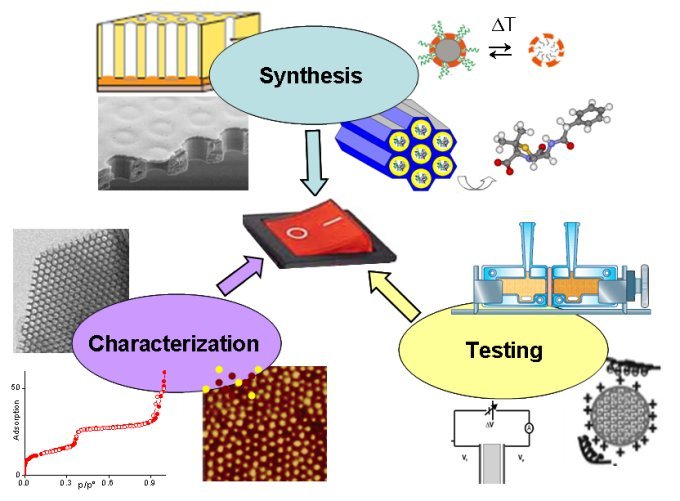OXIPOLYSTI
Development of polymeric and oxidic materials for stimuli responsive applications
Aree / Gruppi di ricerca
Partecipanti al progetto
Descrizione del progetto
The term “stimuli responsive” refers to materials that can change their surface properties (e.g. wettability, adhesion, roughness, biocompatibility, etc.) in an accurate and predictable manner as a function of external stimuli, e.g. temperature and pH change, irradiation, magnetic/electric field, etc. The potential applications in areas ranging from innovative medicine to microchip analyses (most of all included in the thematic priorities defined by EU VII FP) implies that the generation of know-how on the preparation and properties of these materials could be pivotal for technology transfer to small and medium enterprises.
Often, stimuli responsive materials are also hybrid ones, coupling an organic part (molecules or macromolecules) with an inorganic one (oxides or metals) through electrostatic or covalent binding. This allows to merge in a single system the peculiar properties of two classes of substances. For instance, polymers are intrinsically stimuli responsive since they change their molecular configuration as a function of temperature and pH. When coupled with high surface area oxides (in particular ordered mesoporous ones), it is possible to obtain nanovalves or molecular gates, that is materials with pores that can be opened and closed on demand. Moreover, the biocompatibility of siliceous materials makes them suitable for <i>in vivo</i> applications, such as controlled and target-specific drug delivery.
The aim of the present project is therefore the development of innovative stimuli responsive materials for topical/dermatological formulations and microfluidic devices, including a laboratory device for dissemination purposes. These targets will be pursued by combining the complementary expertises of a young researchers team, including competences in the fields of polymers, oxides, nanostructured surfaces, analytical methodologies and pharmaceutical formulations.
A naïf scheme of the project ideas and activities is here depicted.

Risultati e pubblicazioni
S. Sapino, E. Ugazio, L. Gastaldi, I. Miletto, G. Berlier, D. Zonari, S. Oliaro-Bosso
Mesoporous silica as topical nanocarriers for quercetin: characterization and in vitro studies
http://hdl.handle.net/2318/153319
Berlier G, Gastaldi L, Ugazio E, Miletto I, Iliade P, Sapino S
Stabilization of quercetin flavonoid in MCM-41 mesoporous silica: positive effect of surface functionalization
http://hdl.handle.net/2318/130166
Berlier G, Gastaldi L, Sapino S, Miletto I, Bottinelli E, Chirio D, Ugazio E
MCM-41 as a useful vector for rutin topical formulation: Synthesis, characterization and testing
http://hdl.handle.net/2318/146325
Roberto Nisticò,Giuliana Magnacca,Markus Antonietti,Nina Fechler
'Salted Silica': Sol-Gel Chemistry of Silica under Hypersaline Conditions
http://hdl.handle.net/2318/146165
R. Nisticò, G. Magnacca, M. Antonietti, N. Fechler
Highly porous silica glasses and aerogels mase easy: The hypersaline route
http://hdl.handle.net/2318/153365
L. Iannarelli, R. Nisticò, P. Avetta, M. Lazzari, G. Magnacca, P. Calza, D. Fabbri, D. Scalarone
Composite membranes with hydrophilic nanopores derived from the self-assembly of block copolymer supramolecular complexes
http://hdl.handle.net/2318/152888
R. Nisticò, D. Scalarone, G. Magnacca
Preparation and physico-chemical characterization of large-mesopore silica thin films templated by block copolymers for membrane technology
http://hdl.handle.net/2318/148617
Ivana Miletto, Annalisa Massa,Elena Ugazio,Giorgia Musso,Giuseppe Caputo,Gloria Berlier
The protective effect of the mesoporous host on the photo oxidation of fluorescent guests: a UV-Vis spectroscopy study
http://hdl.handle.net/2318/146404
Elena Balantseva, Ivana Miletto, Salvatore Coluccia, Gloria Berlier
Immobilisation of Zinc porphyrins on mesoporous SBA-15: Effect of bulky substituents on the surface interaction
http://hdl.handle.net/2318/146333
Note
Partecipanti al progettoBerlier Gloria (Coordinatore)
Magnacca Giuliana
Brunella Valentina
Scalarone Dominique
Ferrari Anna Maria
Casassa Silvia
Calza Paola
Fabbri Debora




